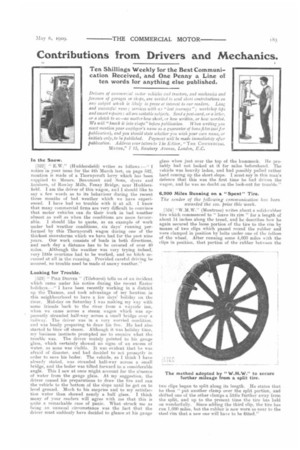Contributions from Drivers and Mechanics.
Page 21

If you've noticed an error in this article please click here to report it so we can fix it.
Ten Shillings Weekly for the Best Communi. cation Received, and One Penny a Line of ten words for anything else published.
Drivers of commercial rnotor vehicles and tractors, and mechanics and foremen of garages or sh4s, are invited to send short contributions on any subject whwh is likely to prove 01 interest to our readers. Long and successful runs ; services with ni "lost journeys" ; workshop tips and smart repairs : all are suitable subjects. Send a post-card, or a letter, or a sketch to us—no matter how short, or how written, or how worded.
We will "knock it into shape" before publication. When writing yon must mention your employer's name as a quarantee of bona files (not Jr publication), and you should state whether you wish your own name, or initials only, to be published. Payment will be made immediatety after publication. Address your letters to '1 he Editor, "THE COMMERCIAL
Moron," 7 15, Rosebery Avenue, London, E,C.
In the Snow.
[522] " (Huddersfield) writes as follows :—" I notice in your issue for the 4th March last, on page 542, mention is made of a Thornycroft lorry which has been supplied to Messrs. Beaumont and Sons, dyers and finishers, of Rowley Mills, Fenay Bridge, near .HiulderSfield. I am the driver of this wagon, anl I should like to say a few words as to its behaviour during the recent three months of had weather which we have experienced. I have had no trouble with it at all. I know that many commercial firms are very difficult to convince that motor vehicles can do their work in bad weather almost as well as when the conditions are more favourable. 1 should like to quote, as an example of work under bad weather conditions, six days' running performed by this Thornycroft wagon during one of the thickest snowstorms which we have had for the past nine years. Our work consists of loads in both directions, and each day a distance has to be covered of over 40 miles. Although the weather was very trying indeed, very little overtime had to be worked, and no bitch occurred at all in the running. Provided careful driving be assured, no trouble needbe made of snowy weather."
Looking for Trouble.
'L5231 " PILE DRIVER " (Tilehurst) tells us of an incident. which came under his notice during the recent Easter holidays.—" I have been recently working in a district up the Thames, and took advantage of my location in this neighbourhood to have a few days' holiday on the river. Mid-day on Saturday I was making my way with some friends back to the river from a wayside inn, when we came across a steam wagon which was apparently stranded half-way across a small bridge over a rail way. The driver was in a very worried condition, and was busily preparing to draw his fire. He had also started to blow off steam. Although it was holiday time, my business instincts prompted me to enquire what the trouble was. The driver mutely pointed to his gauge glass, which certainly showed no signs of an excess of water, as none was visible. It was evident that he was afraid of disaster, and had decided to act promptly in order to save his boiler. The vehicle, as I think I have already stated, was stranded half-way across a small bridge, and the boiler was tilted forward to a considerable angle. This I saw at once might account for the absence of water from the gauge gldss. At my suggestion, the driver ceased his preparations to draw the fire and ran the vehicle to the bottom of the slope until he got on to level ground. Much to his surprise and to my-satisfaction water then showed nearly a half glass. I think many of your readers will agree with me that this is quite a remarkable case of panic. What struck me as being an unusual circumstance was the fact that the driver must suddenly have decided to glance at his gauge
glass when just over the top of the hummock. Iie probably had not looked at it for miles beforehand. The vehicle was heavily laden, and had possibly pulled rather hard coming up the short slope. I must say in this man's defence that this was the first time he had driven the wagon, and he was no doubt on the look-out for trouble."
6,200 Miles Running on a " Spent " Tire.
The sender of the following communication has been awarded the zos. prize this week.
[i24] "W.M.W." (Montrose) writes about a solid-rubber tire which commenced to " leave its rim " for a length of about 14 inches along the tread, and he describes how he again secured the loose portion of the tire to the rim by means of two clips which passed round the rubber and were clamped in position by bolts under one of the felloes of the wheel. After running some 4,600 miles with the clips in position, that portion of the rubber between the two clips began to split along its length. He states that he then " put another clamp over the split portion, and shifted one of the other clamps a little further away from the split, and up to the present time the tire has held on wonderfully. Since adding the third clip, the tire has run 1,600 miles, but the rubber is now worn so near to the steel rim that a new one will have to be fitted."






















